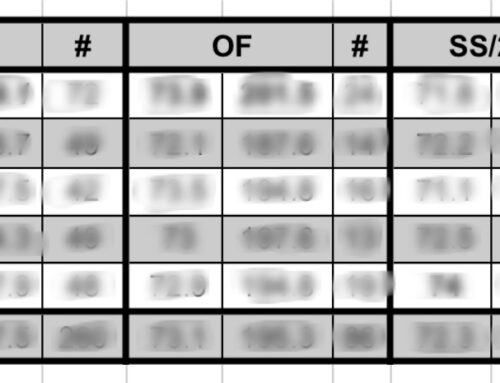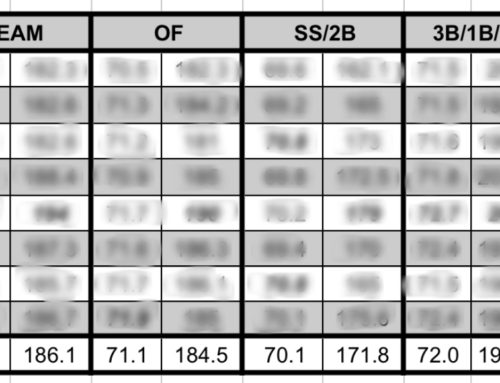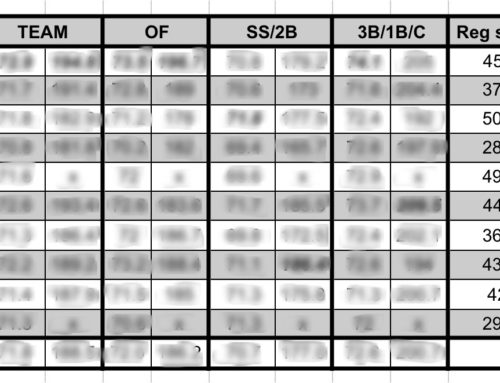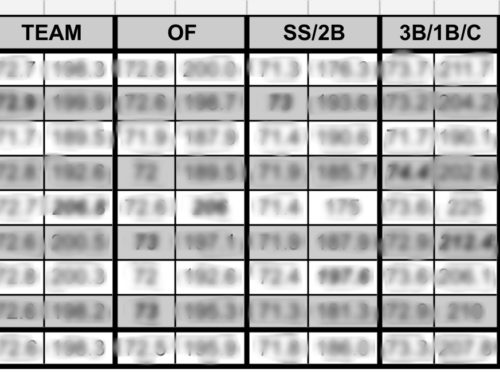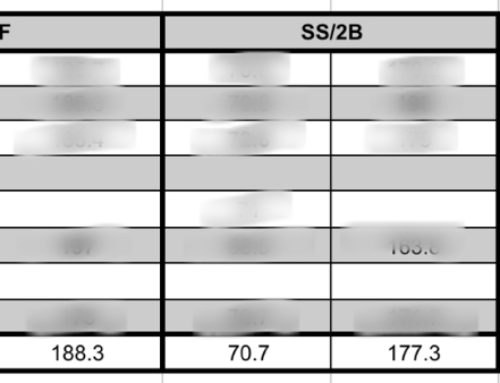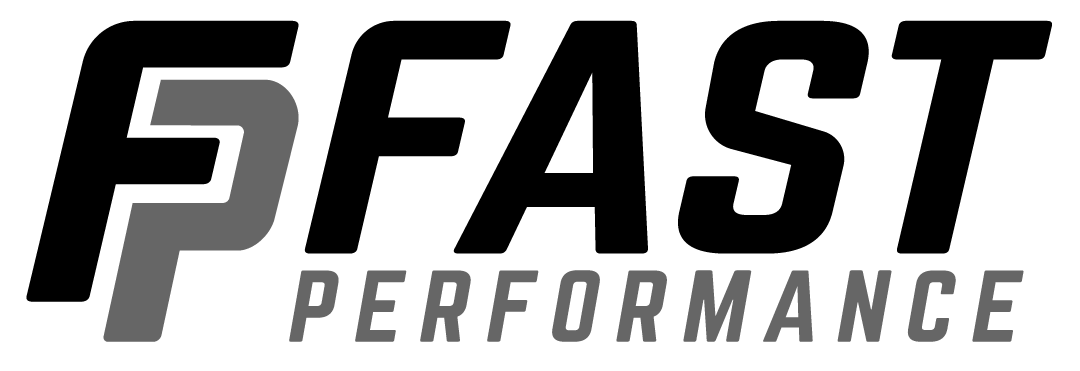How do I reach the next level of baseball? My son loves baseball and wants to pursue it for as long as he possibly can. What do I need to do to help him accomplish this? Players and parents, have you ever asked yourself these questions? I am sure you have, otherwise, you wouldn’t be reading this. We often are told that the best way to accomplish this goal is to play as often as possible. The big-box baseball organizations around the State of Colorado tell you that you must play for their teams to get seen by the most eyes. They market themselves with the big-name players who have come through their building and the big-name schools they’ve sent them to. I want to apologize to you since these organizations won’t. The names you see and the professional clubs glued to a big wall in the facility are all facades. These showcase teams had nothing to do with those kids getting scholarships or drafted. Those kids possessed the talent and the skills required to make those steps at the next level. But this is part of the marketing genius that these organizations have perfected. Johnny Allstar played for my team, and he signed with this professional organization; therefore, you must play within my organization if you want to have a chance at the next level. I want to be the first to tell you; you do not need to spend thousands of dollars to play for a team for three months traveling all over the nation to get a scholarship.
Often when we look at the process of recruiting or scouting in the game of baseball, we become filled with fear because it is often confusing. What do I need to know about playing at the next level? Am I being seen as often as is necessary to be recruited? How do I compare against others in my class, and how can I put myself ahead of the pack. These questions have far more straightforward answers than we give them credit for. As will be discussed in this article, there are some parameters that athletes should strive to reach to gain the most attention from colleges and professional organizations. Before we dive further into this topic, I have a couple of questions to ask of the athletes reading this. What do you have as a baseball player that makes you stand out from the rest of the crowd? Why would a college coach want to use a scholarship to bring you to its school, or why would a professional organization use a draft pick on you? If you can’t answer these questions, it is time to get to work.
*This article is not for the players who only want to play high school/club baseball in high school and only want to play for fun. This article is for the players who desire to play at the highest level they can, whether that be college or professionally.
Why Do I Want to Play Fall Ball?
The most common reason for a baseball athlete to play in the fall depends on the individual athlete’s age gap. Seniors in high school, particularly those that do not have a college commitment, are in a unique position because, under normal circumstances, those kids need to get seen by college coaches to become a committed college athlete. These athletes have very little time to mess around because their window of opportunity is closing. Coaches around the country are always looking for new talent to bring into their programs to maintain a winning culture or create that winning culture. So they take strategic trips to find these players.
Conversely, lower level grade kids, say Freshman-Junior year of high school, play because of the belief that more games equal more reps. Thus, I get better as a player because I have exposed myself to more in-game scenarios that a gym cannot replicate. The belief that playing more games improves players’ chances to play at the next level entices players and parents to seek top-level competition around the nation to enhance their skills.
I believe that players, especially underclassmen, should ask themselves these questions when considering playing Fall Baseball. Take these questions and their subsequent answers seriously, because the correct solution can mean the difference between a ticket to the next level or a lot of wasted money with nothing to show for it.
Do I Fulfill the Size Necessary for the Position I Want to Play?
Most players go through their high school years severely underweight. Due to this lack of size, it becomes increasingly difficult to gain the necessary physical strength to perform at a high level. Size and strength will almost always make you stand out to coaches on the field. Coaches love to see the guys who can be immediate contributors to their squads in the spring. Taking time to develop yourself into a near-finished or finished product by the time you graduate high school will give you the best chances of getting a scholarship.
Below is a chart of the last 5 Major League Baseball Drafts. The table shows the heights and weights of high school players taken in the first five rounds of each draft, respectively. I took the maximum and the minimums of height and weight to show that outliers exist, but the averages are where most must pay attention. I took the average weight divided by the average height to develop a “ratio” for the minimum necessary weight for quality to perform (a la Dr. Josh Heenan).
| Position | 2020 | 2019 | 2018 | 2017 | 2016 | Avg: |
| Pitcher | ||||||
| Height (inches) | ||||||
| Max | 77 | 78 | 78 | 78 | 79 | |
| Min | 72 | 73 | 73 | 73 | 72 | |
| Avg | 74.7 | 75.6 | 75.2 | 75.1 | 76.04 | |
| Weight (lbs) | ||||||
| Max | 225 | 225 | 243 | 239 | 238 | |
| Min | 165 | 170 | 168 | 160 | 165 | |
| Avg | 195.5 | 193.5 | 198.3 | 195 | 200.7 | |
| Ratio | 2.6 | 2.5 | 2.6 | 2.6 | 2.6 | 2.58 |
| Catcher | ||||||
| Height | 1 Drafted | |||||
| Max | 74 | N/A | 72 | 75 | 70 | |
| Min | 72 | N/A | 72 | 71 | 70 | |
| Avg | 73 | N/A | 72 | 73 | 70 | |
| Weight (lbs) | ||||||
| Max | 205 | N/A | 200 | 232 | 205 | |
| Min | 195 | N/A | 200 | 185 | 205 | |
| Avg | 200 | N/A | 200 | 202 | 205 | |
| Ratio | 2.7 | N/A | 2.7 | 2.6 | 2.9 | 2.72 |
| Corner Infielder | ||||||
| Height | ||||||
| Max | 77 | 75 | 76 | 76 | 79 | |
| Min | 74 | 72 | 73 | 73 | 70 | |
| Avg | 75.5 | 74 | 74 | 74.1 | 73.6 | |
| Weight | ||||||
| Max | 220 | 210 | 220 | 215 | 237 | |
| Min | 215 | 180 | 178 | 185 | 175 | |
| Avg | 218.75 | 196.6 | 202 | 193.3 | 210.6 | |
| Ratio | 2.9 | 2.6 | 2.7 | 2.6 | 2.8 | 2.72 |
| Middle Infielder | ||||||
| Height | ||||||
| Max | 75 | 75 | 72 | 74 | 74 | |
| Min | 71 | 69 | 68 | 68 | 72 | |
| Avg | 72.8 | 72.2 | 70.2 | 72.3 | 73.2 | |
| Weight | ||||||
| Max | 200 | 195 | 181 | 226 | 210 | |
| Min | 175 | 160 | 145 | 166 | 183 | |
| Avg | 183.75 | 174 | 167.4 | 189 | 193.6 | |
| Ratio | 2.5 | 2.4 | 2.4 | 2.6 | 2.6 | 2.5 |
| Outfield | ||||||
| Height | ||||||
| Max | 77 | 75 | 77 | 75 | 77 | |
| Min | 71 | 70 | 71 | 72 | 70 | |
| Avg | 73.33 | 72.5 | 73.5 | 73.5 | 74.4 | |
| Weight | ||||||
| Max | 210 | 230 | 205 | 215 | 225 | |
| Min | 160 | 165 | 165 | 170 | 170 | |
| Avg | 188 | 187 | 183.8 | 190.4 | 203 | |
| Ratio | 2.5 | 2.5 | 2.5 | 2.6 | 2.7 | 2.56 |
As shown in the charts, the average ratio has stayed pretty consistent over the last five drafts. Pitchers, Middle Infielders, and Outfielders stay around a height/weight ratio of 2.5, while Catchers and Corner Infielders are around 2.7. For example, a 6’1 athlete would need to weigh at 182.5 lbs to perform at a high level, on average.
While these numbers are not law for success in baseball, they do present a clear pattern as to the size of high-performance athletes. I do not want guys to be discouraged by the listed heights in the charts. Pitchers do not have to be 6’2 to be successful in baseball and that is what makes baseball great! Some examples would be:
Marcus Stroman (NYM): 5’7” 180lbs; Height to Weight Ratio: 2.64
Brandon Bailey (HOU): 5’10” 195lbs; Height to Weight Ratio: 2.78
Randy Johnson (HOF): 6’10” 225lbs; Height to Weight Ratio: 2.74
*Heights and weights are taken from Baseball Reference
Do I Meet the Raw Skills to Impress A Coach or Scout?
We live in a data-driven baseball economy now. Anything and everything that can be measured and verified is, and coaches are aware of this fact. Baseball programs around the nation have a limited supply of scholarships to pass around to prospective players (11.7 in Division 1, 9 in Division 2, No athletic scholarships in Division 3, 12 in NAIA, and 27 in JUCO). Coaches need to be strategic with that money to field the best team possible, year in and year out. As you read this right now, do you possess the raw talent to entice any coach to give you a scholarship? While one division of baseball is not any better than the other, another article for another day, you, as a player, need to be able to look attractive enough to coaches across the spectrum to identify the best fit for you. That is what separates us at FAST from other facilities in Colorado; our primary job is to get kids good enough to have many options so that they can have the power to make their own decisions. The baseball world is more data-driven than ever before and the ability to verify any physical metric is easy with a simple Google search. No longer can you expect to tell a coach how hard you throw or how fast you run without verified radar gun readings and times taken. Therefore, you as an athlete need to be able to prove that things you say to a prospective coach.
So what are these raw skills that I need to possess? Well, that depends on position and level, but a lot of them have overlap:
Pitchers:
| Velocity | DI | DII | DIII | NAIA | JUCO |
| RHP | 86-95+ | 85+ | 82+ | 85+ | 82+* |
| LHP | 84-92+ | 81+ | 80+ | 81+ | 80+* |
* Discrepancies depending on the level of JUCO; high level closer to DI, while lower-level programs are more in line with DIII
Key Takeaways: As may be completely obvious, velocity is king! Higher velocities are more attractive to potential coaches because it is easier to make a pitcher that throws hard develop a capable arsenal than a kid that doesn’t throw hard.
Catchers:
| Metrics | DI | DII | DIII | NAIA | JUCO |
| Pop Times | 1.95 or better | 2.0 or better | 2.1 or better | 2.0 or better | 2.1 or better* |
* Same as Pitchers depends on the level of the JUCO.
Key Takeaways: Please note that I hate the emphasis on Pop Times for Catchers, but this is a vital tool to have to be recruited. That said, the faster a catcher can take the ball from his glove and get it to 2nd base draws a lot of eyes.
Corner Infielders:
| Metrics | DI | DII | DIII | NAIA | JUCO |
| 60 Yard Dash | 7.25 or better | 7.25 or better | 7.35 or better | 7.25 or better | 7.35 or better |
| Home to First | |||||
| INF Velocity | 85+ MPH | 80+ | 80+ | 80+ | 80+ |
Key Takeaways: While Corner Infielders do not have to be the fastest guys on the field, they need to throw the ball hard. If you want to play 3rd base at the collegiate level or maybe even professionally, you need to get the ball across the diamond quickly.
Middle Infielders:
| Metrics | DI | DII | DIII | NAIA | JUCO |
| 60 Yard Dash | 6.8 or better | 6.9 or better | 7.25 or better | 7.25 or better | 7.25 or better |
| Home to First | 4.1 or better | 4.3 or better | 4.4 or better | 4.3 or better | 4.4 or better |
| INF Velocity | 85+ MPH | 80+ | 75+ | 80+ | 75+ |
Key Takeaways: Middles need to be swift and cover a large amount of the field to make tough plays. Adding an ability to throw the ball hard across the field can be the difference between getting only one runner or turning the double play.
Outfielders:
| Metrics | DI | DII | DIII | NAIA | JUCO |
| 60 Yard Dash | 6.8 or better | 6.8 or better | 7.30 or better | 6.8 or better | 7.30 or better |
| Home to First | 4.1 or better | 4.2 or better | 4.3 or better | 4.2 or better | 4.3 or better |
| OF Velocity | 85+ MPH | 82-86+ MPH | 78+ MPH | 82-86+ MPH | 78+ MPH |
Key Takeaways: Obviously, the ability to cover the most amount of space in the field is necessary to play in the outfield. Centerfielders need to be faster than their counterparts, but speed on the corners only helps. Arm strength is also vital to outfielder’s abilities, and keeping base runners from taking the extra base.
Do I Possess the Technical Skills to Make it at the Next Level?
Physical stature can only take you so far; many kids look the part but do not have high-level college players’ abilities. Serious skill development needs to go hand in hand with building a solid athlete with raw skills. As shown in the charts below, as is no surprise, DI baseball players are absolute studs. An athlete needs to be a total dude, to be taken seriously for the highest level of collegiate baseball and potentially in the professional ranks. After DI, the level of entry goes down through the other levels. Your priority is to make yourself as attractive to as many college coaches as possible regardless of the level. Thus it would make sense to develop the skills to make yourself the best player you are capable of being. If our goal is to be the best player that we are capable of, how do we know what the ceiling is if we never test where the limit is?
Pitchers:
| Metrics | DI | DII | DIII | NAIA | JUCO |
| Command | At least 3 Pitches | 1 offspeed pitch, and 1 other to spots | 1 offspeed and developing another | 1 offspeed and developing another | Developing Command |
| ERA | Under 2.00 | Under 3.00 | Under 3.50 | Under 2.50 | Under 4.00 |
| K/INN. | >1 | ≥1 | 1 | 1 | 1 |
| W/ 2 INN. | <1 | ≤1 | 1 | 1 | 1 |
Catchers:
| Metrics | DI | DII | DIII | NAIA | JUCO |
| Slugging | .600 | .550 | .500 | .500 | .450 |
| OBP | .500 | .450 | .400 | .400 | .350 |
| ERA | Below 2.00 |
Key Takeaways: Catchers need the ability to hit and a high baseball IQ to keep your pitching staff as productive as possible. Catchers need a solid ability to call pitches and keep your pitchers in check.
Corner Infielders:
| Metrics | DI | DII | DIII | NAIA | JUCO |
| Slugging | .750 | .600 | .550 | .500 | .500 |
| OBP | .500 | .450 | .400 | .400 | .400 |
| HR | 5-10 | 3-8 | 3+ | 3+ | 2+ |
| RBIs | 35+ | 30+ | 25+ | 25+ | 20+ |
Key Takeaways: Corner Infielders, no surprise here, need to hit and hit the ball with power. A 1st or 3rd baseman should be a reliable bat in the lineup and can get runs scored with his bat.
Middle Infielders:
| Metrics | DI | DII | DIII | NAIA | JUCO |
| Slugging | .600 | .450 | .500 | .500 | .450 |
| OBP | .500 | .550 | .400 | .400 | .350 |
Key Takeaways: Middle Infielders need to be able to get hits and with occasional power.
Center Fielders:
| Metrics | DI | DII | DIII | NAIA | JUCO |
| Slugging | .600 | .500 | .500 | .500 | .450 |
| OBP | .500 | .450 | .400 | .400 | .350 |
Key Takeaways: Similar to Middle Infielders
Corner Outfielders
| Metrics | DI | DII | DIII | NAIA | JUCO |
| Slugging | .750 | .700 | .650 | .650 | .650 |
| OBP | .500 | .450 | .400 | .400 | .400 |
Key Takeaways: Similar to Corner Infielders
What Can I Do to Make Myself Stand Out Amongst my Competitors?
The simple answer is TRAIN!! Train for velocity, train for power, train for speed, and a quick first step, training is often the easiest way to develop great players, yet it is the most neglected aspect of a player’s development. Velocity is not a magical skill that appears out of nowhere; it results from proactive attention to detail. As a pitcher, you need to be strong and move efficiently to throw the ball hard enough for coaches to be interested. Similarly, with hitting, high exit velocity needs to be trained, and a hitter needs to be able to draw power from their legs and powerfully rotate to hit the ball hard. How can those attributes be trained when you are regularly playing games? Developing these abilities is nearly impossible on a significant scale without a dedicated time frame to build those skills.
How does a pitcher develop a great new pitch? He dedicates a lot of time to build it in the gym. How does a centerfielder develop a quick first step and get to top speed to get to a ball in the gap? He gets in touch with a certified strength and conditioning coach that can develop that athleticism. Training in the offseason yields the most noticeable changes from season to season, bar none. If you want the most natural path to put yourself ahead of your peers and be on the list of college coaches around the nation, TRAIN!!
Conclusion:
Circumstances differ for everyone. If you are a senior who is not committed to a college, playing may be the right option for you. I will write another blog soon about why traveling to showcases may also not be in your best interest. If you are an underclassmen in high school and want to play at the next level, Fall Baseball is most likely not worth it. You need to develop the physique, abilities, and skills that will make you more attractive to college coaches and professional scouts. The path is in front of you, and until now, you may not have taken that path too seriously. But, at FAST, we are confident that we can develop you into the player you want to be and give you the ability to be successful not only at the high school level but also at the next level. We live in
Sources:
- “MLB Draft Tracker.” MLB.com, www.mlb.com/draft/tracker.
- “College Baseball Recruiting Guidelines.” College Baseball Recruiting Guidelines | What Coaches Look For, www.ncsasports.org/baseball/recruiting-guidelines.
- “PLAYER SKILL GUIDELINES.” All American Baseball Academy, www.allamericanbaseballacademy.com/pages/590/335/0/.
